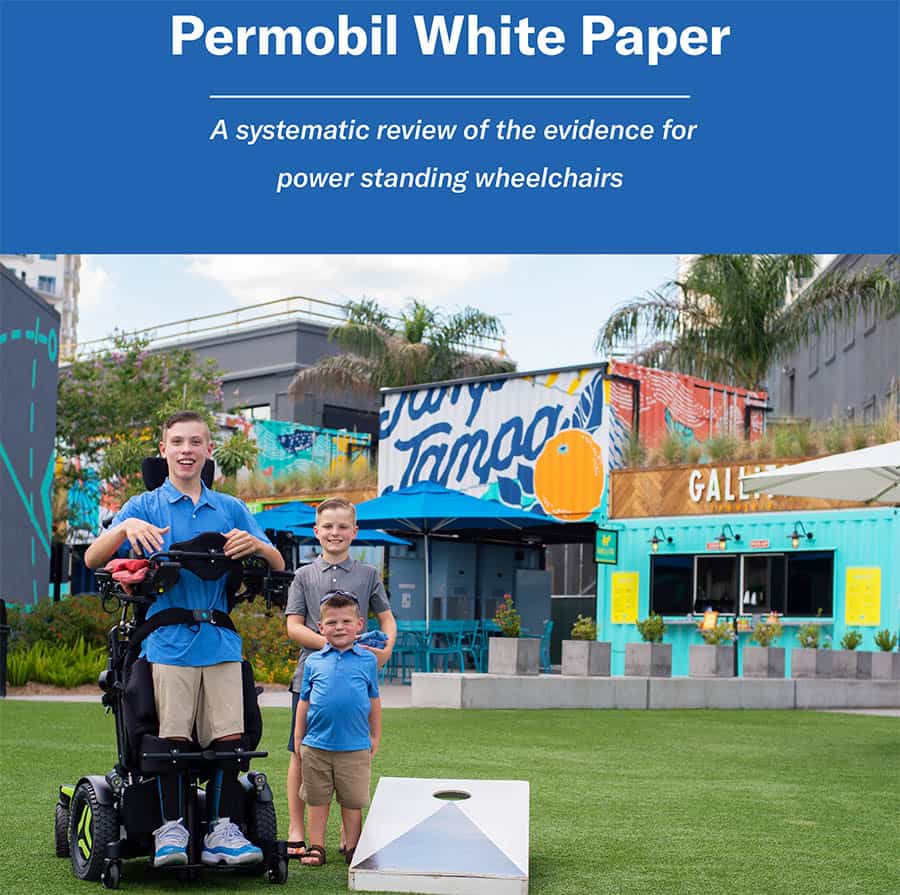Whitepaper examines how powered standing wheelchairs improve clinical outcomes

Permobil, which manufactures a range of mobility and seating solutions, has published a new whitepaper that explores the use of powered standing wheelchairs for providing clinical outcomes and improvement of functions.
Powered standing wheelchairs can extend these clinical outcomes to the domestic and community situation, adding additional functionality and also psychosocial outcomes.
The report defines power standing as: “…a system that encompasses the ability for a standing system (consistent of multiple actuators and power seat functions such as tilt, recline, elevating legs, and seat elevate) to be utilised in its full capacity upon a power wheelchair base.
“This combination of seat functions and power base allow the user to optimally achieve both a seated and standing position within the system, while enabling the user to access his/her environment with the use of mobility.”
The whitepaper – ‘ Permobil White Paper: A systematic review of the evidence for power standing wheelchairs’ – examines the benefits of power standing.
Its overall aim is to provide evidence for as to why users should have access to a power standing wheelchair to not only minimise the health risks of sitting, but to improve their overall health, performance of activities of daily living, social interactions, and mental well-being.
How the evidence was collected
A systematic literature review was performed to identify all the clinical, functional and psychosocial effects of standing. After Permobil searched for evidence about power standing across a wide range of academic publications, 41 publications were chosen to inform Permobil’s whitepaper.
As well as the systematic literature review, Permobil used data from its MyPermobil application that connects users’ phones to their powerchair. The data offers insights from a large group of users worldwide into how Permobil powerchair users are using their power seat functions.
Additionally, Permobil conducted an internal global survey in December 2020 of 120 staff members involved in sales and clinical education. These employees were asked for their views on users’ needs for those using a power standing wheelchair. Results from this survey are included in the paper where appropriate to give additional insights.
Pictures and quotes from a Permobil wheelchair user who was followed closely after receiving his standing power wheelchair are also included in the report to visualise and explain the scientific evidence provided.
Key clinical benefits
The whitepaper explores some of the clinical benefits of standing and using power wheelchairs. AT Today has summarised some of these key clinical benefits to standing and using powered wheelchairs.
The report found that standing leads to offloading and to an altered reactivity of skin temperature and thus has the potential to decrease the risk of pressure injuries. Adults that stand can effectively redistribute pressure to avoid developing pressure ulcers.
Permobil’s paper also looked at how standing and power wheelchairs can help users achieve a full range of motion. Often due to injuries or diseases, wheelchair users are at risk of losing full range of motion, the document notes.
The literature indicates that power standing could benefit range of motion and muscle length both in children and in adults with a diversity of mobility impairments. It notes, however, that not all studies found clinically significant results.
The whitepaper recommends that wheelchair users begin standing as soon as possible after onset or diagnosis of mobility impairment since standing appears less effective in individuals with long-standing contractures.
In addition, evidence suggests that standing in a power wheelchair allows adjusting the position to manage pain and comfort level, but Permobil states that it is important to monitor pain and comfort, particularly in the early stages.
Key functional benefits
Alongside the clinical benefits of using a powered wheelchair to stand, the report highlights some of the functional benefits. Functional benefits include accessing unmodified areas of living spaces, such as kitchen counters, light switches, storage cupboards, and bathroom sinks, that would otherwise be inaccessible to wheelchair users without a standing function.
AT Today has underlined some of the key functional benefits to standing and using powered wheelchairs.
The paper explains: “Functional benefits can be achieved as an indirect or direct result of standing. Direct benefits refer to immediate impact of power standing on function, whereas indirect benefits refer to the longer-term impact of clinical and psychosocial benefits which lead to functional benefits.”
Overall, the report found that power standing leads to functional benefits in activities of daily living, communication and education.
Evidence from both questionnaires and interviews show an increased independency with power standing at home and at school. Power standing wheelchairs might lead to more functional benefits compared to other standing devices because of less restrictions in daily use, such as not needing to transfer.
Permobil further emphasises that having a powered standing wheelchair is more cost-effective than adapting the individual’s home, which can be both expensive and time-consuming. Powered standing wheelchairs can enable users to access different parts of their home with ease.
Download the full whitepaper here

